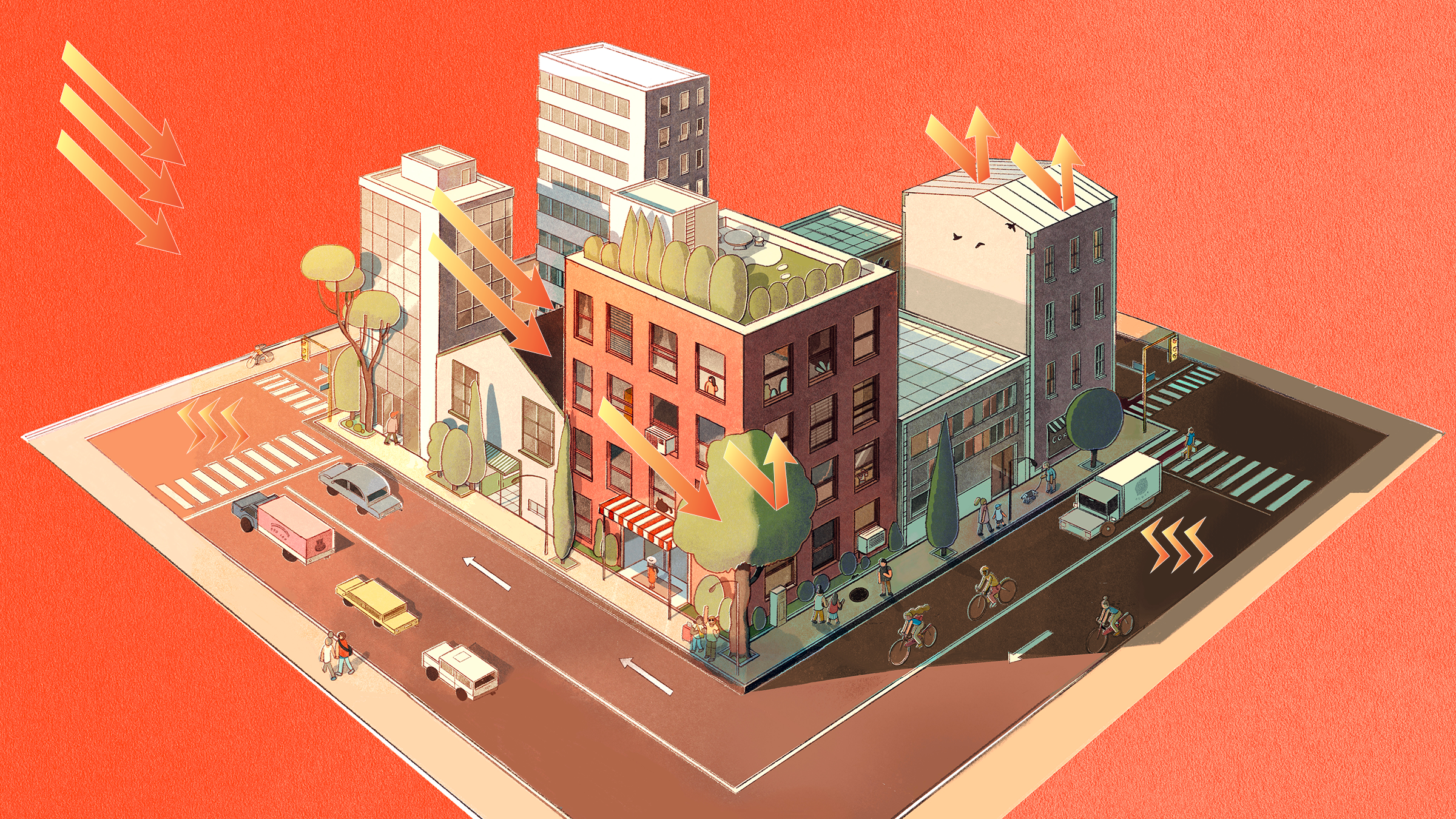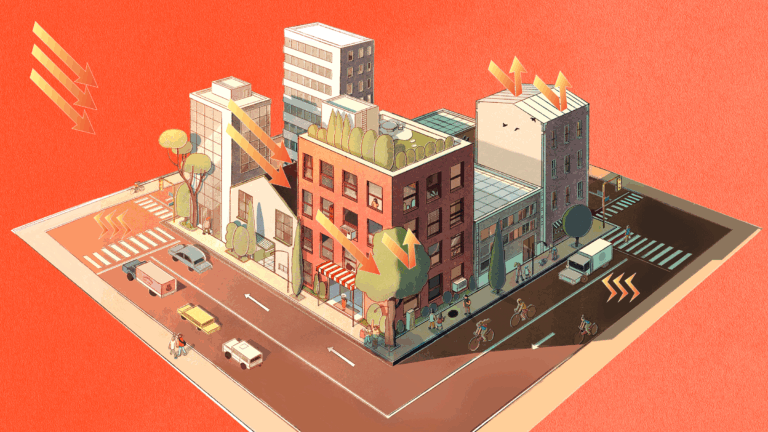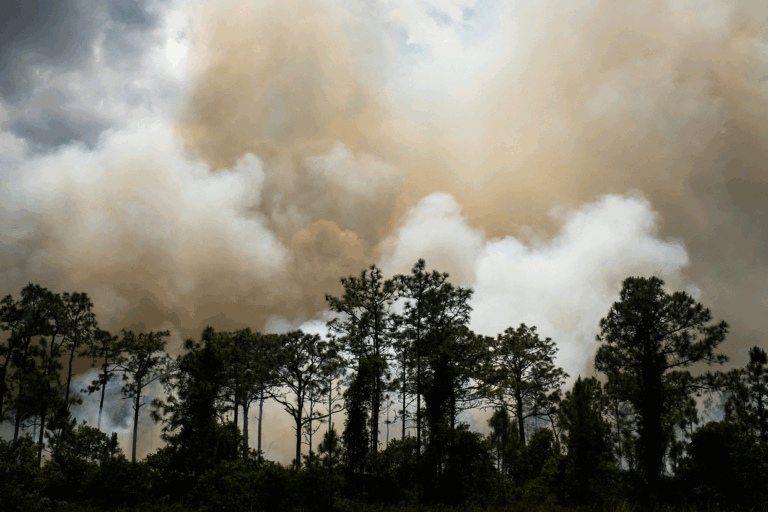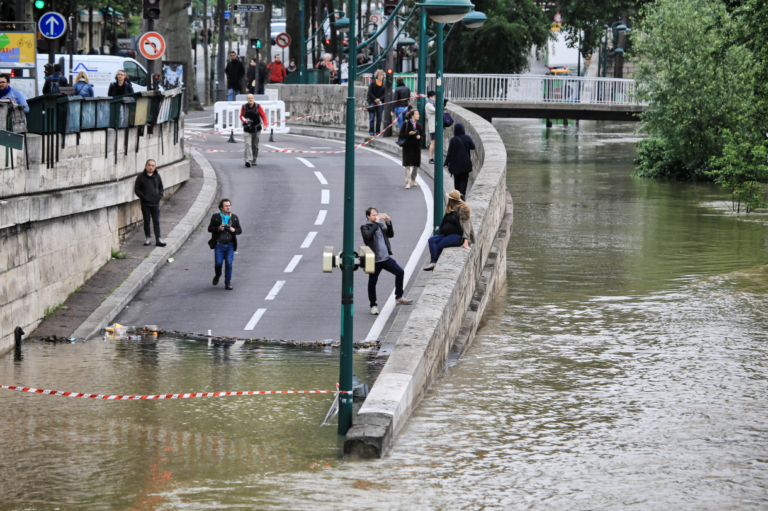Standing on a city sidewalk during the summer can feel sweltering compared to lying under a shady tree in an open, breezy field. Urban areas can be upwards of 7 to 9°F (4 to 5°C) warmer than their surroundings because of the urban heat island effect. This heat-amplifying effect is an unintended consequence of how we have designed and built our cities.
For people living in cities, the urban heat island effect poses serious health risks from heat-related illnesses to even death. As the climate warms, higher temperatures are amplifying the urban heat island effect. But we can adapt our cities to reduce the urban heat island effect and adapt to the growing dangers of rising temperatures and extreme heat.
What is the urban heat island effect?
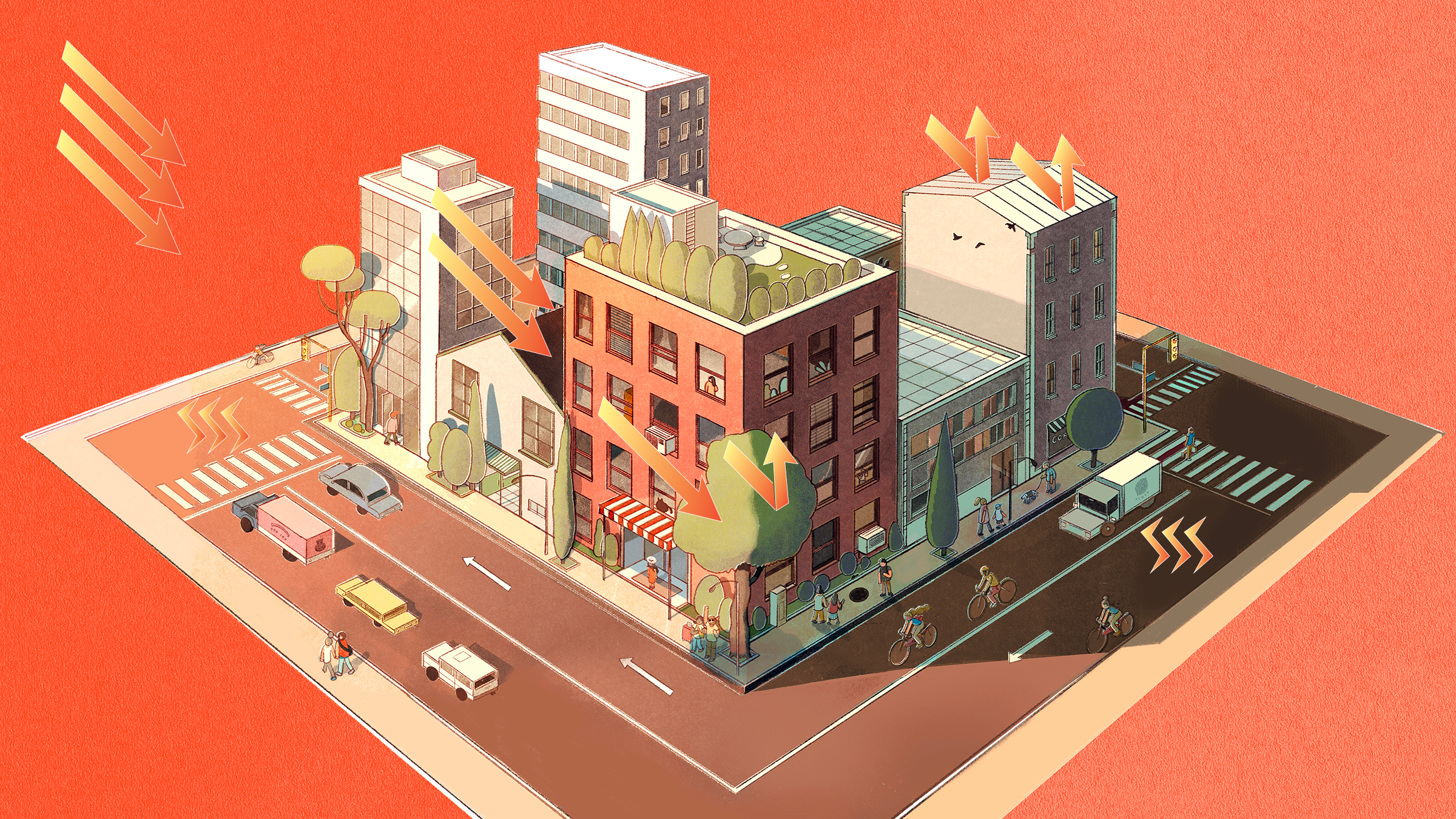
Illustration by Lisk Feng
The urban heat island effect is a phenomenon in which built-up urban areas are hotter than surrounding rural ones. This happens because cities are packed with buildings, materials, and human activities that absorb, store, and release heat slowly. In contrast, rural areas tend to have more vegetation, trees, and open land that provide shade and help cool the air.
Consider how much hotter it feels to stand on black asphalt in direct sunlight compared to under a tree in a grassy park. The same principles play out on a larger scale across entire cities and lead to the urban heat island effect. For people in hotter urban areas, this can mean sweltering walks to the grocery store, sleepless nights without relief, more time spent indoors, and increased strain on their health and well-being.
The urban heat island effect can differ from neighborhood to neighborhood within the same city. In neighborhoods that historically experienced little city government investment in green spaces, and heat-reducing building materials, the urban heat island effect is intensified. Historical building practices like building a highway through a neighborhood also add heat to an area and reduce the amount of green space. These differences contribute to unequal exposure to heat and corresponding heat-related risks.
What causes the urban heat island effect?
The urban heat island effect is a product of urban design and development, not climate change. The design and build of our cities, from the shape of buildings and properties of building materials to the lack of green spaces and high heat-emitting ways in which we live, causes the urban heat island effect. Here are the four key contributors:
Building materials
Common building materials like brick, asphalt, and concrete have a high thermal mass, meaning they absorb large amounts of heat during the day and release it slowly, especially at night. This delayed heat release is one reason cities can stay warm long after the sun goes down.
Many of these building materials are also darker in color, which gives them a low albedo, a term that describes how much sunlight a surface reflects. Dark, low-albedo materials reflect very little sunlight and instead absorb most of it, further contributing to heat.
Building shape and placement
When we build tall, wide buildings packed closely together, they can trap heat and block airflow, preventing cooler air from circulating and allowing heat to remain in the area. This dense design creates urban canyons—narrow spaces between buildings that prevent air from circulating and allow heat to build up.
One way researchers can identify urban canyons is with the sky view factor, a measure of how much of the sky is visible from the ground. In areas where buildings are tall and tightly packed, the sky view factor is low, meaning less heat can escape, remaining trapped near the surface. This blocked sky contributes to heat retention, reduced ventilation, and higher temperatures.
Trees and vegetation
The amount of space for trees, parks, and other green areas contributes to the urban heat island effect. Vegetation helps cool cities by providing shade and releasing water vapor through a natural process called evapotranspiration, in which plants take up water through their roots and release it through their leaves. Cities tend to have far less vegetation than rural or natural landscapes. With fewer trees and green spaces, cities lack a natural cooling process.
Human activity
How we live, work, and move around in cities contributes to the urban heat island effect. Cars, factories, air conditioners, and other machines all give off heat, which adds to the warmth of a city, because their motors generate heat.
What are the impacts of the urban heat island effect?
The urban heat island effect increases the severity of heat-related risks and impacts. Heat is currently the deadliest weather-related hazard. In the U.S., heat causes more deaths than hurricanes, tornadoes, floods, winter storms, or any other extreme weather event.
With rising temperatures due to global climate change, heat-related risks are growing, and the urban heat island effect is intensifying them further in some places. It is estimated that the urban heat island effect raises the risk of death by 45% or more during periods of extreme heat, and, in certain heatwaves, has contributed to an estimated 50% or more of the deaths that occurred.
The urban heat island effect impacts heat-related risks across human health, activity, and infrastructure.
Human health
For people with certain health conditions, the urban heat island effect increases the risks of heat-related illnesses such as heat exhaustion or heatstroke and exacerbates existing conditions like heart and respiratory diseases. Intensified heat from the urban heat island effect can also trigger stress responses, cause discomfort, and disrupt sleep, which can stress our physical and mental health. For vulnerable groups such as pregnant women, young children, and the elderly, the added heat can take a greater toll on well-being and heighten the risk of heat-related illnesses.
Human productivity
The urban heat island effect can disrupt how we work, learn, and go about our daily lives. Increased temperatures create more dangerous and less efficient working conditions for people doing outdoor and manual labor. As of 2024, heat-related labor productivity losses were estimated to cost the U.S. around $100 billion a year. Heat also affects education, impairing children’s ability to concentrate and learn and leading to reduced academic performance, learning loss, and missed school days.
Infrastructure
The urban heat island effect can compromise infrastructure. Higher temperatures reduce the efficiency of power plants, drive up energy demand for cooling, and can strain the electric grid and contribute to power blackouts. Roadways, railways, and bridges can also expand or buckle under extreme temperatures, disrupting transportation.
How can cities address the urban heat island effect?
Cities can address the urban heat island effect by preparing for heat-related risks and adapting as those risks grow with climate change. Through preparation and adaptation, heat-related deaths and illnesses are preventable.
Here are some examples of how cities could adapt to increased heat:
- Expanding urban greenery. Planting trees and adding parks, gardens, and green roofs can provide shade and release moisture to cool cities naturally.
- Installing reflective materials. Using reflective, lighter-colored building materials on roofs, roads, and pavements can increase albedo and reflect more sunlight. This helps buildings and streets stay cooler by absorbing less heat during the day.
- Ensuring access to cooling. Making cooling technologies like air conditioning available in residences, workplaces, and schools can prevent heat-related illness and death, especially during extreme heat.
- Opening public cooling centers. Free, air-conditioned spaces such as libraries, community centers, and museums can give people without effective cooling at home access to relief and hydration during heatwaves.
- Implementing heat warning systems and community outreach. Setting up early alert systems and neighborhood-level efforts like checking in on neighbors can keep people informed and protected during extreme heat.
- Increasing climate literacy. Promoting education about heat risks, prevention strategies, and warning signs can empower people to stay safe and take action during extreme heat.
City governments in Phoenix, Paris, and Ahmedabad are dealing with rising heat-related risks from the urban heat island effect with a combination of adaptation strategies:
- Phoenix, Arizona. Locals in Phoenix have grappled with rising temperatures for the past two decades as extreme heat and heat-related deaths have increased. In response, the city’s government significantly expanded its heat adaptation efforts by investing in reflective surfaces, shade structures, tree planting, cooling centers, and warning systems.
- Paris, France. Paris, with its dense architecture, zinc rooftops, and limited green space, is a city especially vulnerable to the urban heat island effect. To reduce heat-related risks, the city’s government has launched public awareness campaigns and reimagined the city’s design by planting more trees along boulevards, adding rooftop gardens, and redesigning streets with cooler pavement materials.
- Ahmedabad, India. Residents of Ahmedabad face growing heat challenges made worse by rapid urbanization, limited infrastructure, and the danger of living in informal settlements—residential areas outside government control and lacking structurally sound homes. In response, the city government launched a heat action plan and partnered with local community organizations to increase public awareness, develop a climate surveillance system, and introduce low-cost cooling initiatives like painting roofs with reflective white paint.
